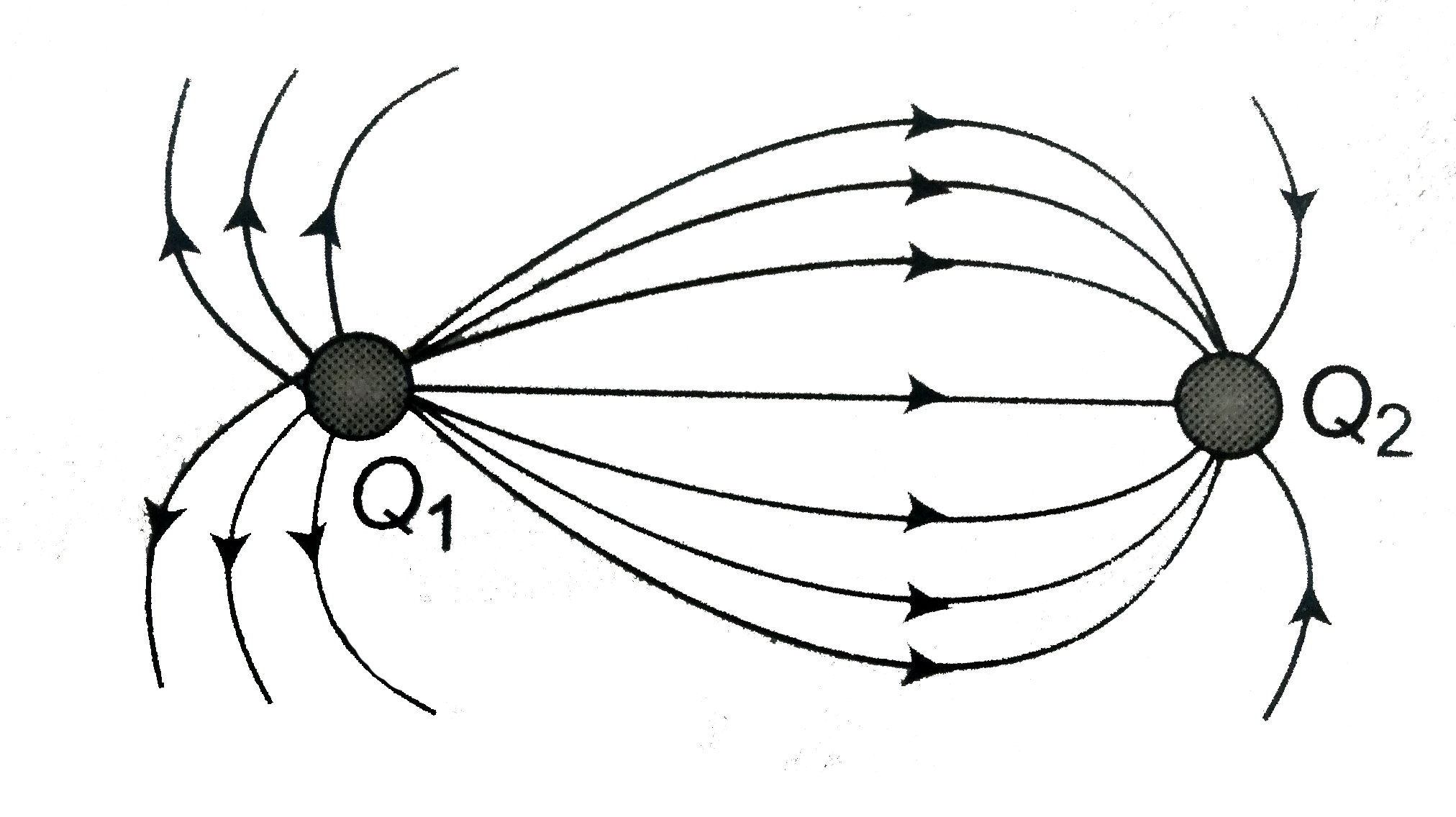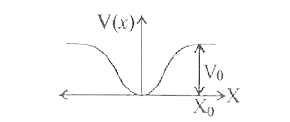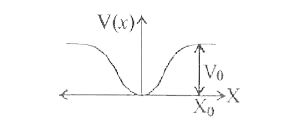When a particle of mass m moves on the x-axis in a potential of the form V(x)=kx2 it performs simple harmonic motion. The correspondubing time period is proprtional to √mh, as can be seen easily using dimensional analusis. However, the motion of a particle can be periodic even when its potential energy increases on both sides of x=0 in a way different from kx2 and its total energy is such that the particle does not escape toin finity. Consider a particle of mass m moving on the x-axis. Its potential energy is V(x)=ax4(a>0) for |x| neat the origin and becomes a constant equal to V0 for |x|impliesX_(0) (see figure).
(##JMA_CHMO_C10_032_Q01##).
For periodic motion of small amplitude A,the time period (T) of thes particle is proportional to.
A√mα
1A√mα
A√αm
1A√αm
The correct Answer is:B
Step by step video, text & image solution for When a particle of mass m moves on the x-axis in a potential of the form V(x) =kx^(2) it performs simple harmonic motion. The correspondubing time period is proprtional to sqrtm/h, as can be seen easily using dimensional analusis. However, the motion of a particle can be periodic even when its potential energy increases on both sides of x=0 in a way different from kx^(2) and its total energy is such that the particle does not escape toin finity. Consider a particle of mass m moving on the x-axis. Its potential energy is V(x)=ax^(4)(agt0) for |x| neat the origin and becomes a constant equal to V_(0) for |x|impliesX_(0) (see figure). (##JMA_CHMO_C10_032_Q01##). For periodic motion of small amplitude A,the time period (T) of thes particle is proportional to. by Physics experts to help you in doubts & scoring excellent marks in Class 12 exams.
Topper's Solved these Questions
- BOOK - JEE ADVANCED PREVIOUS YEARCHAPTER - JEE ADVANCEDEXERCISE - Section -IV (Integer type)10videos
JEE ADVANCED
- BOOK - JEE ADVANCED PREVIOUS YEARCHAPTER - JEE ADVANCEDEXERCISE - Section-I (single correct choice type)6videos
JEE ADVANCED
- BOOK - JEE ADVANCED PREVIOUS YEARCHAPTER - JEE ADVANCEDEXERCISE - Section-II (Multiple correct choice type)5videos
JEE ADVANCED
- BOOK - JEE ADVANCED PREVIOUS YEARCHAPTER - JEE (ADVANCE) 2020EXERCISE - SECTION 36videos
JEE (ADVANCE) 2020
- BOOK - JEE ADVANCED PREVIOUS YEARCHAPTER - JEE ADVANCED 2020EXERCISE - SECTION-36videos
JEE ADVANCED 2020
Similar Questions
The focal length of a thin biconvex lens is 20cm. When an object is moved from a distance of 25cm in front of it to 50cm, the magni-fication of its image changes from m25→m50. The ratio m25m50 is.
01:37View SolutionA vernier calipers has 1mmmarks on the main scale. It has 20 equal divisions on the Vernier scale which match with 16 main scale divisions. For this Vernier calipers, the least count is
09:29View SolutionA few electric field lines for a system of two charges Q1 and Q2 fixed at two different points on the x-axis are shown in the figure. These lines suggest that
(i) |Q1|>|Q2|
(ii) |Q1|<|Q2|
(iii) At a finite distance to the left of Q1 the electric field is zero
(iv) At a finite distance to the right of Q2 the electric field is zero
 06:19View Solution
06:19View SolutionA spherical bubbles inside water has radius R . Take the pressuere in the bubbled and the water pressure to be pv. The bubble now gets compressed radially in an adiabatic manner so that its raduis becomes (R - a) . For a<<R the magnitude of the work done in the process is given by (4πpoRa2)X. where X is a a constant and y=Cp/Cv=41/30. The value of X is
View SolutionPut a unifrom meter scale horizontally on your extended index fingers with the left one at 0.0 cm and the right one at 90.00 cm when you attempt to move both the fingers slowly towards the center , initially only the left finger slips with respect to to the scale and the right finger does not . after some distance, the left finger stops and the right one starts slipping . Then the right finger stops at a distance XR from the center (50.00 cm ) of the scale and the left one starts slopping again . This happens because to the difference in the fiictional forces on the two fingers . it the coefficients of static and dynamic between the fingers and the scale are 0.4 and 0.32 respectively , the value of XR (in cm is ...........
06:11View SolutionA particle of mass 2 kg moves in simple harmonic motion and its potential energy U varies with position x as shown. The period of oscillation of the particle is
02:54View SolutionWhen a particle is mass m moves on the x- axis in a potential of the from V(x) = kx^(2) , it performs simple harmonic motion. The corresponding thime periond is proportional to sqrt((m)/(k)) , as can be seen easily asing dimensional analysis. However, the motion of a pariticle can be periodic even when its potential enem increases on both sides x = 0 in a way different from kx^(2) and its total energy is such that the particel does not escape to infinity. consider a particle of mass m moving onthe x- axis . Its potential energy is V(x) = alpha *x^4 (alpha gt 0 ) for |x| near the origin and becomes a constant equal to V_(0) for |x| ge X_(0) (see figure) If the total energy of the particle is E , it will perform is periodic motion why if :
06:08View Solutionयदि किसी सरल आवर्त करते कण का मध्यमान स्थिति से विस्थापन x हो तो सरल आवर्त गति करते कण कि कुल ऊर्जा -
02:56View Solutionजब m द्रव्यमान का एक कण :-अक्ष पर V(x) = kx2', स्थितिज ऊर्जा से गतिमान होता है, तब यह सरल आवर्त गति करता है। इसका आवर्तकाल √mk के समानुपाती होता है, जो कि विमीय विश्लेषण द्वारा आसानी से निकाला जा सकता है। हालाँकि, यदि किसी एक कण की स्थितिज ऊर्जा x = 0 के दोनों तरफ kx2 से । भिन्न तरह से बढ़े तथा कण की कुल ऊर्जा इतनी हो कि वह अनन्त तक पलायन न कर सके, तब भी कण की गति आवर्ती हो सकती है। m द्रव्यमान का एक कण x-अक्ष पर गति करता है जहाँ । x | के केन्द्र के पास होने पर स्थितिज ऊर्जा V(x) = ax4, (a>0) है तथा |x|>X0 के लिए स्थितिज ऊर्जा V(x) = V0, है (चित्र देखें) .
Q. यदि एक कण की समग्र ऊर्जा E है, तो वह आवर्ती गति करेगा केवल जबकि View Solution
View Solutionजब m द्रव्यमान का एक कण :-अक्ष पर V(x) = kx2', स्थितिज ऊर्जा से गतिमान होता है, तब यह सरल आवर्त गति करता है। इसका आवर्तकाल √mk के समानुपाती होता है, जो कि विमीय विश्लेषण द्वारा आसानी से निकाला जा सकता है। हालाँकि, यदि किसी एक कण की स्थितिज ऊर्जा x = 0 के दोनों तरफ kx2 से । भिन्न तरह से बढ़े तथा कण की कुल ऊर्जा इतनी हो कि वह अनन्त तक पलायन न कर सके, तब भी कण की गति आवर्ती हो सकती है। m द्रव्यमान का एक कण x-अक्ष पर गति करता है जहाँ । x | के केन्द्र के पास होने पर स्थितिज ऊर्जा V(x) = ax4, (a>0) है तथा |x|>X0 के लिए स्थितिज ऊर्जा V(x) = V0, है (चित्र देखें) .
Q. कम आयाम A के दोलन के लिए, कण का आवर्तकाल T निम्न में से किसके समानुपाती है View Solution
View Solutionजब m द्रव्यमान का एक कण :-अक्ष पर V(x) = kx2', स्थितिज ऊर्जा से गतिमान होता है, तब यह सरल आवर्त गति करता है। इसका आवर्तकाल √mk के समानुपाती होता है, जो कि विमीय विश्लेषण द्वारा आसानी से निकाला जा सकता है। हालाँकि, यदि किसी एक कण की स्थितिज ऊर्जा x = 0 के दोनों तरफ kx2 से । भिन्न तरह से बढ़े तथा कण की कुल ऊर्जा इतनी हो कि वह अनन्त तक पलायन न कर सके, तब भी कण की गति आवर्ती हो सकती है। m द्रव्यमान का एक कण x-अक्ष पर गति करता है जहाँ । x | के केन्द्र के पास होने पर स्थितिज ऊर्जा V(x) = ax4, (a>0) है तथा |x|>X0 के लिए स्थितिज ऊर्जा V(x) = V0, है (चित्र देखें) .
Q |x|> X0 के लिए कण का त्वरण- 01:57View Solution
01:57View Solutionजब m द्रव्यमान का एक कण X -अक्ष पर V(x)=kx2 स्थितिज ऊर्जा से गतिमान हॉट अहा , तब यह सरल आवर्त गति करता है। इसका आवर्तकाल √mk के समानुपाती होता है, जो की विमीय विश्लेषण द्वारा आसानी से निकाला जा सकता है। हालांकि यदि किसी एक कण की स्थितिज ऊर्जा x=0 के दोनों और kx2 से भिन्न तरह से बड़े, तथा कण की कुल ऊर्जा इतनी हो की वह अनंत एक पलायन न कर सके, तब भी कण की गति आवर्ती हो सकती है। m द्रव्यमान का एक कण X -अक्ष पर गति करता है, जहां ।x। के केंद्र के पास होने पर स्थितिज ऊर्जा V(x)=αx4(alph>0) है तथा ।x।≥X0 के लिए स्थितिज ऊर्जा V(x)=V0 है

यदि एक कण की समग्र ऊर्जा E है तो वह आवर्ती गति तभी संपन्न कर सकता है, केवल जब02:20View SolutionA particle of mass m is executing oscillations about the origin on the x-axis. Its potential energy is V(x)=kx^(2) . Where k is a positive constant. If the amplitude of oscillation is a, then its time period T is……………
02:22View SolutionWhen a particle of mass m moves on the X-axis in a potential of the form V(x) = kx^(2) , it performs simple harmonic motion. The corresponding time period is proportional to sqrt((m)/(k)) , as can be seen easily using dimensional analysis. However, the motion of a particle can be periodic even when its potential energy increases on both sides of x = 0 in a way different from kx^(2) and its total energy is such that the particle does not escape to infinity. Consider a particle of mass m moving on the X-axis. Its potential energy is V(x) =a x^(2) (a gt 0) for |x| near the origin and becomes a constant equal to V_(0) for |x| ge X_(0) For periodic motion os small amplitude A . The time periodic T of this particle is proportional to
02:48View SolutionWhen a particle of mass m moves on the X-axis in a potential of the form V(x) = kx^(2) , it performs simple harmonic motion. The corresponding time period is proportional to sqrt((m)/(k)) , as can be seen easily using dimensional analysis. However, the motion of a particle can be periodic even when its potential energy increases on both sides of x = 0 in a way different from kx^(2) and its total energy is such that the particle does not escape to infinity. Consider a particle of mass m moving on the X-axis. Its potential energy is V(x) =a x^(2) (a gt 0) for |x| near the origin and becomes a constant equal to V_(0) for |x| ge X_(0) The acceleration of this particle for |X|>X_(0) is
03:41View Solutionएक कण आयाम A से सरल आवर्त गति कर रहा है। जब इसकी स्थितिज ऊर्जा इसकी कुल ऊर्जा की आधी हो, तब कण का विस्थापन क्या होगा?
03:23View Solution

